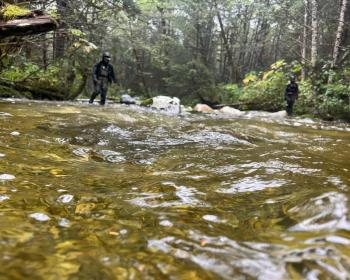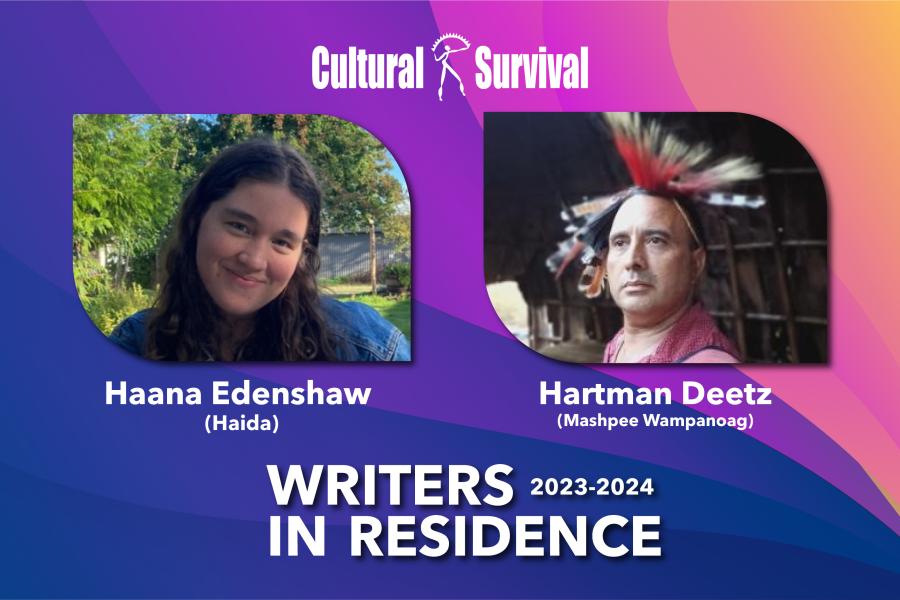Traditional Ecological Knowledge (TEK) is the system of knowledge gained by experience, observation, and analysis of natural events that is transmitted among members of a community In a subsistence economy, TEK is used to find, harvest, process, store, and sustain natural resources that are needed for food, clothing, and shelter. It also includes the ability to recognize, avoid, and get out of dangerous situations. TEK is a system for organizing one's observations, sharing them with others, and receiving their knowledge in return -- it is the knowledge needed for physical and cultural survival in a subsistence society.
TEK is built on recognizing patterns in the environment in order to understand migrations and other cyclical events that can be relied upon for food and safety It is equally important to be aware of the irregular, unpredictable events and conditions that can disrupt normal activities and on occasion, threaten one's life. It is acquired through listening to elders' stories and lessons.
In the Arctic, indigenous groups are calling for recognition of the value of TEK, especially in regards to conservation, development, and the survival of indigenous cultures. A number of research projects, conferences, and workshops on various aspects of TEK have been held to explore the ways in which it can be documented, applied, and perpetuated. From 1995 to 1998, I led a study to document TEK of beluga whales in Alaska and Russia. My experiences with the Alaska portion of that project help illustrate the significance of TEK in a subsistence culture and the issues surrounding its documentation and application.
Documenting TEK of Beluga Whales
In 1991, the governments of the eight Arctic countries -- Canada, Denmark (Greenland), Finland, Iceland, Norway, the Russian Federation, Sweden, and the U.S. -- signed the Arctic Environmental Protection Strategy (AEPS), a plan to improve cooperation on environmental issues. The Saami Council, the Association of Indigenous Peoples of the North, Siberia, the Far East of the Russian Federation, and the Inuit Circumpolar Conference (ICC) were included as part of the strategy. From the beginning, these organizations emphasized the importance of TEK to research and conservation.
In 1993, Lorraine Brooke, on behalf of ICC, wrote a review of TEK projects that could serve as examples of how to include TEK in activities under the AEPS. A pilot project resulted, endorsed by the Arctic countries, to document TEK of beluga whales in Alaska and Chukotka, Russia. The project was designed to show how TEK contributes to research and conservation. I collaborated with Nikolai I. Mymrin of Provideniya, Chukotka, who was responsible for the research in Russia.
I conducted the study in Point Lay, Buckland, and Norton Bay, Alaska. Three communities in Norton Bay -- Elim, Koyuk, and Shaktoolik-had recently formed their own Marine Mammal Commission that provided local management of beluga hunting. I made four trips to each community to introduce the project, to conduct the primary research session and a review session, and to present the final report. The communities and the participants in the study were closely involved in all steps and reviewed the draft reports before they were published to ensure that nothing would harm the community's interests. I could not have completed the project without their help and trust.
I believe the process of a study is as important as the results. In settings where community members and researchers emphasize the importance of TEK, the actual process of documenting TEK is viewed with great concern. Some community members worry that their proprietary information will be used by others, either to the detriment of community interests or to the benefit of the researcher without a corresponding benefit to the community. Some researchers, on the other hand, are concerned about the quality of the information and whether it accurately portrays the natural world or is skewed by subjective interpretations. While a collaborative process cannot allay either concern entirely, it helps to build a sense of trust and shared enterprise that is essential to a productive research partnership.
We documented ecological understanding of beluga whales, from migratory routes, predation, and behavior in sea ice, to interactions with other animals and responses to human activities. One of the more striking results came when participants in one group interview started talking about beaver. I thought the discussion had strayed a little too far from the marine environment and was thinking of ways to steer conversation back -- at least to the ocean -- when one of the eiders noticed my confusion. "Don't you see?" he asked. "The beaver populations are increasing, they dam the streams where fish spawn, and that affects the fish that beluga eat." While clear as day when explained, I would never have anticipated a connection between beaver and beluga. This level of understanding, of recognizing the tight web connecting various animals and components of the local environment, is the essence of TEK.
Equally significant were the observations of human-beluga interactions. Belugas are sensitive to noise and in the old days, there were strict rules at hunting camps forbidding any unnecessary sounds. In the Buckland area, the local abundance of belugas has declined sharply in the last 20 years. While this decline may represent a population decline, it is perhaps a shift in distribution resulting from increases in local boat traffic and other disturbances. The decline near Buckland worries residents of Point Lay, because there is talk of developing a rich coal deposit and building a causeway and a deep water loading facility south of the village. The causeway would be in the middle of a crucial gathering area for belugas each spring and would disrupt the area and the belugas, which in some years, account for two-thirds of the village's annual subsistence production.
Also, the community's knowledge was finally recorded and compiled for its own sake as a result of TEK documention of beluga whales. Biologists studying belugas in Alaska have long recognized the importance of local expertise and have acknowledged its use in their research. Nonetheless, the published reports blend TEK and scientific findings so that the contribution of TEK is not immediately apparent or, as sometimes happens, is relegated to anecdotes in contrast to scientific fact. While my research made no major new discoveries, the participants saw the final report as their report, describing their knowledge. This reaction appeared satisfying to them, and was certainly rewarding to me.
Applying TEK
With belugas, as with other species used for subsistence in Alaska, research and management decisions must be made. How can TEK contribute to this process? In addition, communities are concerned about perpetuating this intimate knowledge of the land and sea, and the spiritual connection underlying their interaction with the environment. With today's barrage of influences from the outside world, can younger generations keep their community's knowledge current and vital?
One offshoot of this project was the Seminar on Documentation and Application of Indigenous Knowledge held in Inuvik, Northwest Territories, Canada, in November 1996. The seminar included 58 participants from Alaska, Canada, Greenland, and Russia. Over half the participants were indigenous and all had some level of experience with TEK either through research or in practice. The seminar produced recommendations covering the perpetuation of TEK at the community level, community consultations and involvement, documentation, application, integration, and training for both researchers and communities.
One recommendation stated that "Co-management itself should be recognized as an application of TEK." In the case of belugas in Alaska, the Alaska Beluga Whale Committee (ABWC) brings hunters, elders, researchers, and managers together to discuss beluga harvests and research, identify concerns, and answer important questions that arise. The ABWC provides a forum that blends the expertise of its members and develops a better overall understanding of belugas and associated management issues. For the community representatives, it is a means to protect an important subsistence activity and emphasizes their concerns and expertise. For the government agency representatives, it is a means to provide effective management and avoid crises, while increasing the scope and effectiveness of their research.
Community members of the ABWC provide harvest reports and other information to the committee. They also help scientists collect samples for DNA and other analysis, and work through the ABWC to help design appropriate studies to answer important questions. For example, little is known about offshore migrations of belugas or their distribution during winter. Hunters have suggested satellite tags to track belugas. In other cases, satellite tags have been criticized as cruel to the animals. In this case, there seems to be a consensus that the information is important enough to warrant using satellite tags. Hunters help capture the belugas (which has proved difficult, if not impossible, without their expertise) and review the results. There are few other examples of such levels of cooperation between hunters and managers. The key is the continuing participation and trust among members of the committee.
While committees like the ABWC have made progress in using TEK, it is less clear how TEK can be perpetuated within the communities. During my research, some of the elders expressed regret that the project had not been carried out 20 years earlier "because those people really knew their stuff." While some of this sentiment can be attributed to modesty, it undoubtedly reflects a real loss of detailed environmental knowledge. The difference between today's elders and youth is far greater. Elders spent a considerable portion of their lives on the land, learning first-hand. Today, children are in school most of the year and their experience with subsistence is limited to occasional hunting, fishing, and gathering trips, often during the summer when school is out.
Some programs seek to balance modern changes and perpetuate cultural practices and knowledge, including TEK. At a recent workshop on sustainable development in Anchorage, Ronald Brower St. of Barrow, Alaska, described efforts to reintroduce the qargi, or `community house,' where young people learn from their elders. The qargi will not replace the school, but complement it, bringing the elders back into the education of younger generations. Also, schools are making adjustments to their calendars that allow children to participate in seasonal hunting and fishing activities throughout the year. Whether such programs succeed depends on the students' interest and the continued relevance of TEK to modern pursuits.
Conclusions
In a report to the ABWC about the Inuvik Seminar, Jerry Norton of Kivalina, Alaska said "documentation of TEK is when we learn it, application is when we use it. We live TEK as our way of life. Harpooning a beluga is application." Fundamentally, TEK is the expertise that allows a community to thrive while living in and from its local environment. The visceral relevance of this knowledge must not be forgotten in documenting TEK and applying it in other research and management settings. While TEK has the potential to improve the understanding of resources and increase local participation, it is based on extensive first-hand experience and expertise shared by others. If that first-hand experience is lost, TEK will disappear with it.
Documenting traditional knowledge remains a worthwhile pursuit, if performed with the full cooperation of the community and with respect to their interests. I hope that more work will be done along these lines and that communities will assume a greater role in documenting and perpetuating their own expertise. A thriving subsistence economy depends on a thorough understanding of the resources used in order to harvest them efficiently and conserve them for the long term. When conditions change, TEK must evolve with those changes. The challenge is to maintain the expertise needed to perpetuate subsistence economies and cultures.
Acknowledgements
My research would not have been possible without the support of the communities and the friendship and trust of the participants. Others-too many to name here-provided advice and encouragement. Funding for my research came from the National Science Foundation, the Trust for Mutual Understanding, the U.S. Fish and Wildlife Service, and the Department of Indian Affairs and Northern Development, Canada.
Selected reading
Adams, Marie, Kathy Frost, and Lois Harwood. 1993. "Alaska and Inuvialuit Beluga Whale Committee-An Initiative in At-Home Management." Arctic, 46(2): 134-7.
Brooke, Lorraine F. 1993. The Participation of Indigenous Peoples and the Application of their Environmental and Ecological Knowledge in the Arctic Environmental Protection Strategy. Vol. 1. Ottawa: Inuit Circumpolar Conference.
Ferguson, M.A.D., and F. Messier. 1997. "Collection and Analysis of Traditional Ecological Knowledge About a Population of Arctic Tundra Caribou." Arctic. 50(1):17-28.
Huntington, Henry P. 1998. "Observations on the Utility of the Semi-Directive Interview for Documenting Traditional Ecological Knowledge." Arctic. 51(3).
Huntington, Henry P., and Nikolai I. Mymrin. 1996. Traditional Ecological Knowledge of Beluga Whales: An Indigenous Knowledge Pilot Project in the Chukchi and Northern Bering Seas. Anchorage: Inuit Circumpolar Conference.
Johnson, Martha, ed. 1992. Lore: Capturing Traditional Environmental Knowledge. Ottawa: Dene Cultural Institute and International Development Research Centre. x + 190p.
McDonald, Miriam, Lucassie Arragutainaq, and Sack Novalinga. 1997. Voices from the Bay. Ottawa and Sanikiluaq: Canadian Arctic Resources Committee and the Municipality of Sanikiluaq.
Nakashima, D.J. 1990. Application of Native Knowledge in EIA: Inuit, Eiders, and Hudson Bay Oil. Ottawa: Canadian Environmental Assessment Research Council.
Article copyright Cultural Survival, Inc.



